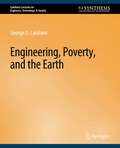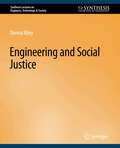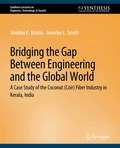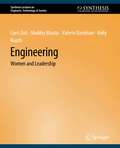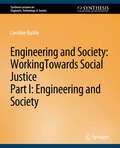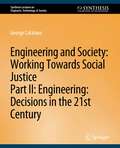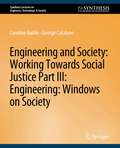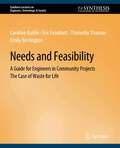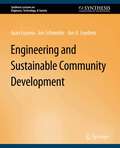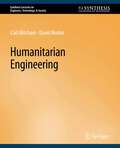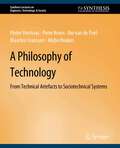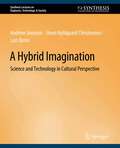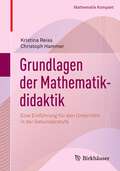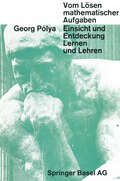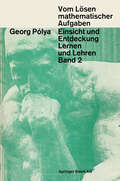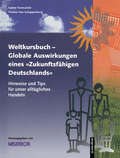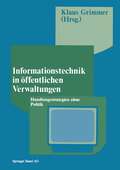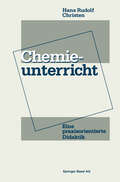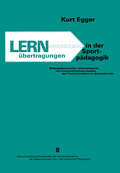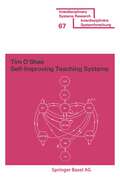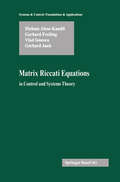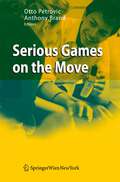- Table View
- List View
Engineering, Poverty, and the Earth (Synthesis Lectures on Engineers, Technology, & Society)
by George D. CatalanoIn the present work, the growing awareness in engineering of the profession’s responsibility towards the environment and the poor is considered. The following approach is taken: a brief overview of the issues of poverty particularly in the U.S. and the deterioration of the natural world with a focus on the Arctic is provided. Case studies involving New Orleans in the aftermath of Hurricane Katrina and the status of polar bears in a time of shrinking Arctic ice cover are detailed. Recent developments in engineering related to the issues of poverty and the environment are discussed. A new paradigm for engineering based on the works of Leonardo Boff and Thomas Berry, one that places an important emphasis upon a community, is explored.
Engineering and Social Justice (Synthesis Lectures on Engineers, Technology, & Society)
by Donna RileyThe profession of engineering in the United States has historically served the status quo, feeding an ever-expanding materialistic and militaristic culture, remaining relatively unresponsive to public concerns, and without significant pressure for change from within. This book calls upon engineers to cultivate a passion for social justice and peace and to develop the skill and knowledge set needed to take practical action for change within the profession. Because many engineers do not receive education and training that support the kinds of critical thinking, reflective decision-making, and effective action necessary to achieve social change, engineers concerned with social justice can feel powerless and isolated as they remain complicit. Utilizing techniques from radical pedagogies of liberation and other movements for social justice, this book presents a roadmap for engineers to become empowered and engage one another in a process of learning and action for social justice and peace. Table of contents: What Do we Mean by Social Justice? / Mindsets in Engineering / Engineering and Social Injustice / Toward a More Socially Just Engineering / Turning Knowledge into Action: Strategies for Change / Parting Lessons for the Continuing Struggle
Bridging the Gap Between Engineering and the Global World: A Case Study of the Coconut (Coir) Fiber Industry in Kerala, India (Synthesis Lectures on Engineers, Technology, & Society)
by Shobha K. Bhatia Jennifer L. SmithOver the last two decades, globalization has had a profound impact on how we view the world and its sustainability. One group of professionals that lies at the heart of sustainability is the engineers. Engineers are trained problem solvers, required to implement technical solutions and are at the forefront of the development of new technologies. Although engineers play a critical role in sustainability, traditional engineering programs typically only focus on the technocentric and ecocentric dimensions of sustainability, providing little training on the sociocentric dimension. With more and more interest in sustainability, it is becoming increasingly important to also provide engineers with an awareness of sociocentric issues and the necessary skills to address them. The aim of this book is to provide engineering educators with a real-life case study that can be brought into existing courses to help bridge the gap between engineering and the global world. The case study focuses on how our engineering study of different natural plant fibers for soil erosion control led us to small villages in Kerala, India, where marginalized women workers often stand waste deep in water several hours a day, clean and beat coconuts by hand, and separate and spin coconut (coir) fibers into yarn by hand, for very low wages. The case study provides insight into the three dimensions of sustainability (technocentric, ecocentric, and sociocentric) and how they come together in a typical engineering problem. Table of Contents: Reinforcing the Classroom / Natural Plant Fibers for Engineering Applications: Technocentric and Ecocentric Dimensions of Sustainability / The Coir Fiber Industry in Kerala, India: Sociocentric Dimension of Sustainability / Case Study / Conclusion / Bibliography
Engineering: Women and Leadership (Synthesis Lectures on Engineers, Technology, & Society)
by Corri Zoli Shobha Bhatia Valerie Davidson Kelly RuschIn this book we explore a sea change occurring in leadership for academic women in the sciences and engineering. Our approach is a two-pronged one: On the one hand, we outline the nature of the changes and their sources, both in various literatures and from program research results. On the other hand, we specify and provide detail about the persistent problems and obstacles that remain as barriers to women’s full participation in academic science and engineering, their career advancement and success, and, most important, their role as leaders in making change. At the heart of this book is our goal to give some shape to the research, practice, and programs developed by women academic leaders making institutional change in the sciences and engineering. Table of Contents: Women in a New Era of Academic Leadership / Background: Academic Leadership for Women in Science and Engineering / Gender and Leadership: Theories and Applications / Women in Engineering Leadership Institute: Critical Issues for Women Academic Engineers as Leaders / From Success Stories to Success Strategies: Leadership for Promoting Diversity in Academic Science and Engineering / Conclusion
Engineering and Society: Engineering and Society (Synthesis Lectures on Engineers, Technology, & Society)
by Caroline Baillie George CatalanoEngineers work in an increasingly complex entanglement of ideas, people, cultures, technology, systems and environments. Today, decisions made by engineers often have serious implications for not only their clients but for society as a whole and the natural world. Such decisions may potentially influence cultures, ways of living, as well as alter ecosystems which are in delicate balance. In order to make appropriate decisions and to co-create ideas and innovations within and among the complex networks of communities which currently exist and are shaped by our decisions, we need to regain our place as professionals, to realise the significance of our work and to take responsibility in a much deeper sense. Engineers must develop the 'ability to respond' to emerging needs of all people, across all cultures. To do this requires insights and knowledge which are at present largely within the domain of the social and political sciences but which need to be shared with our students in ways which are meaningful and relevant to engineering. This book attempts to do just that. In Part 1 Baillie introduces ideas associated with the ways in which engineers relate to the communities in which they work. Drawing on scholarship from science and technology studies, globalisation and development studies, as well as work in science communication and dialogue, this introductory text sets the scene for an engineering community which engages with the public. In Part 2 Catalano frames the thinking processes necessary to create ethical and just decisions in engineering, to understand the implications of our current decision making processes and think about ways in which we might adapt these to become more socially just in the future. In Part 3 Baillie and Catalano have provided case studies of everyday issues such as water, garbage and alarm clocks, to help us consider how we might see through the lenses of our new knowledge from Parts 1 and 2 and apply this to our every day existence as engineers. Table of Contents: Introduction / Engineering and Society / Engineering and the Public / Globalisation, Development, and Technology
Engineering and Society: Decisions in the 21st Century (Synthesis Lectures on Engineers, Technology, & Society)
by Caroline Baillie George CatalanoPart II: Engineering Decisions in the 21st Century Engineers work in an increasingly complex entanglement of ideas, people, cultures, technology, systems and environments. Today, decisions made by engineers often have serious implications for not only their clients but for society as a whole and the natural world. Such decisions may potentially influence cultures, ways of living, as well as alter ecosystems which are in delicate balance. In order to make appropriate decisions and to co-create ideas and innovations within and among the complex networks of communities which currently exist and are shaped by our decisions, we need to regain our place as professionals, to realise the significance of our work and to take responsibility in a much deeper sense. Engineers must develop the 'ability to respond' to emerging needs of all people, across all cultures. To do this requires insights and knowledge which are at present largely within the domain of the social and political sciences but which need to be shared with our students in ways which are meaningful and relevant to engineering. This book attempts to do just that. In Part 1 Baillie introduces ideas associated with the ways in which engineers relate to the communities in which they work. Drawing on scholarship from science and technology studies, globalisation and development studies, as well as work in science communication and dialogue, this introductory text sets the scene for an engineering community which engages with the public. In Part 2 Catalano frames the thinking processes necessary to create ethical and just decisions in engineering, to understand the implications of our current decision making processes and think about ways in which we might adapt these to become more socially just in the future. In Part 3 Baillie and Catalano have provided case studies of everyday issues such as water, garbage and alarm clocks, to help us consider how we might see through the lenses of our new knowledge from Parts 1 and 2 and apply this to our everyday existence as engineers. Table of Contents: Making Decisions in the 21st Century / Ethics / Landmines and the War in Iraq / Hurricane Katrina and the Flooding of New Orleans / Disappearing Bumble Bees / Engineering and Traditional Approaches / Engineering and Freedom / Engineering and Chaos / Engineering and a Morally Deep World / Engineering and Globalism / Engineering and Love / Case Study Application / Final Thoughts
Engineering and Society: Windows on Society (Synthesis Lectures on Engineers, Technology, & Society)
by Caroline Baillie George CatalanoEngineers work in an increasingly complex entanglement of ideas, people, cultures, technology, systems and environments. Today, decisions made by engineers often have serious implications for not only their clients but for society as a whole and the natural world. Such decisions may potentially influence cultures, ways of living, as well as alter ecosystems which are in delicate balance. In order to make appropriate decisions and to co-create ideas and innovations within and among the complex networks of communities which currently exist and are shaped by our decisions, we need to regain our place as professionals, to realise the significance of our work and to take responsibility in a much deeper sense. Engineers must develop the 'ability to respond' to emerging needs of all people, across all cultures. To do this requires insights and knowledge which are at present largely within the domain of the social and political sciences but which need to be shared with our students in ways which are meaningful and relevant to engineering. This book attempts to do just that. In Part 1 Baillie introduces ideas associated with the ways in which engineers relate to the communities in which they work. Drawing on scholarship from science and technology studies, globalisation and development studies, as well as work in science communication and dialogue, this introductory text sets the scene for an engineering community which engages with the public. In Part 2 Catalano frames the thinking processes necessary to create ethical and just decisions in engineering, to understand the implications of our current decision making processes and think about ways in which we might adapt these to become more socially just in the future. In Part 3 Baillie and Catalano have provided case studies of everyday issues such as water, garbage and alarm clocks, to help us consider how we might see through the lenses of our new knowledge from Parts 1 and 2 and apply this to our everyday existence as engineers. Table of Contents: Introduction / Throwing Away Rubbish / Turning on the Tap / Awakened by an Alarm Clock / Driving the SUV / Travelling to Waikiki Beach
Needs and Feasibility: A Guide for Engineers in Community Projects (Synthesis Lectures on Engineers, Technology, & Society)
by Caroline Baillie Eric Feinblatt Thimothy Thamae Emily BerringtonNeeds and Feasibility: A Guide for Engineers in Community Projects -- The Case of Waste for Life is the story of Waste for Life (WFL). WFL is a not-for-profit organization that works to promote poverty-reducing solutions to environmental problems, and its educational branch is an international consortium of universities in six countries, involving students in support of community development projects. WFL currently works in Lesotho and Argentina. We present the story of the development of WFL in each country as a case-based guide to engineers, professors and students interested in community development work, particularly in contexts very different from their own. We focus mainly on the set-up stages, framing the projects to ensure that community needs are adequately articulated and acted upon. We begin with needs assessment, what is it that needs to be done -- for whom and why? How feasible is this, technically, economically, and can we guarantee sustainability? Before we can decide any of this, we need to understand and map the territory -- who are the key players, who have the most influence, and who will be most impacted by what we are doing? What is the role of the local government? If the groups are working as cooperatives, what does this mean, and what are these groups looking for? What is the technical solution going to look like? If it is a product, how will it be marketed? What other social, environmental, and economic impacts will it have and on whom? Once these have all been negotiated, and it is clear that all parties are working towards a mutually acceptable goal, how do we move forward so that any dependence on external partners is removed? When do we bring students into the work? What role can they play? Should they stay at home and support the project from there or is it better to do work in the field? This guide will be useful for the student engineer or the experienced engineer or professor who is interested in moving towards socially just engineering development work but has no idea where to begin. The real difficulties and on the ground issues encountered by the Waste for Life team are presented honestly and with the knowledge that we must learn from our mistakes. Only then can we hope to gain a better understanding of our potential role in supporting community development and move towards a better future. Table of Contents: An Introduction / Assessing the Need in Lesotho / Feasibility of WFL Lesotho / Mapping the Territory in Buenos Aires / Stakeholder Focus: The Local Government / Stakeholder Focus: Cooperatives / Sustainability: Economic, Environmental, and Social / Student Involvement / Summary Thoughts
Engineering and Sustainable Community Development (Synthesis Lectures on Engineers, Technology, & Society)
by Juan Lucena Jen Schneider Jon A. LeydensThis book, Engineering and Sustainable Community Development, presents an overview of engineering as it relates to humanitarian engineering, service learning engineering, or engineering for community development, often called sustainable community development (SCD). The topics covered include a history of engineers and development, the problems of using industry-based practices when designing for communities, how engineers can prepare to work with communities, and listening in community development. It also includes two case studies -- one of engineers developing a windmill for a community in India, and a second of an engineer "mapping communities" in Honduras to empower people to use water effectively -- and student perspectives and experiences on one curricular model dealing with community development. Table of Contents: Introduction / Engineers and Development: From Empires to Sustainable Development / Why Design for Industry Will Not Work as Design for Community / Engineering with Community / Listening to Community / ESCD Case Study 1: Sika Dhari's Windmill / ESCD Case Study 2: Building Organizations and Mapping Communities in Honduras / Students' Perspectives on ESCD: A Course Model / Beyond Engineers and Community: A Path Forward
Humanitarian Engineering (Synthesis Lectures on Engineers, Technology, & Society)
by Carl Mitcham David MunozHumanitarian Engineering reviews the development of engineering as a distinct profession and of the humanitarian movement as a special socio-political practice. Having noted that the two developments were situated in the same geographical and historical space -- that is, in Europe and North America beginning in the 1700s -- the book argues for a mutual influence and synthesis that has previously been lacking. In this spirit, the first of two central chapters describes humanitarian engineering as the artful drawing on science to direct the resources of nature with active compassion to meet the basic needs of all -- especially the powerless, poor, or otherwise marginalized. A second central chapter then considers strategies for education in humanitarian engineering so conceived. Two final chapters consider challenges and implications. Table of Contents: Engineering / Humanitarianism / Humanitarian Engineering / Humanitarian Engineering Education / Challenges / Conclusion: Humanizing Technology
Tragedy in the Gulf: A Call for a New Engineering Ethic (Synthesis Lectures on Engineers, Technology, & Society)
by George CatalanoThe recent tragedy in the Gulf of Mexico and resultant ethical consequences for the engineering profession are introduced and discussed. The need for a new engineering ethic is identified and introduced based upon advancements in science, complex systems and eco-philosophy. Motivations for introducing a new ethic rather than modifying existing ethics are also discussed. Table of Contents: Tragedy in the Gulf / Tragedy Unfolding / Engineering Ethics / Complex Systems / Quantum Mechanics / Evolving Principles of the Universe / A New Engineering Ethic / Epilogue
A Philosophy of Technology: From Technical Artefacts to Sociotechnical Systems (Synthesis Lectures on Engineers, Technology, & Society)
by Peter Vermaas Peter Kroes Ibo van Poel Maarten Franssen Wybo HoukesIn A Philosophy of Technology: From Technical Artefacts to Sociotechnical Systems, technology is analysed from a series of different perspectives. The analysis starts by focussing on the most tangible products of technology, called technical artefacts, and then builds step-wise towards considering those artefacts within their context of use, and ultimately as embedded in encompassing sociotechnical systems that also include humans as operators and social rules like legislation. Philosophical characterisations are given of technical artefacts, their context of use and of sociotechnical systems. Analyses are presented of how technical artefacts are designed in engineering and what types of technological knowledge is involved in engineering. And the issue is considered how engineers and others can or cannot influence the development of technology. These characterisations are complemented by ethical analyses of the moral status of technical artefacts and the possibilities and impossibilities for engineers to influence this status when designing artefacts and the sociotechnical systems in which artefacts are embedded. The running example in the book is aviation, where aeroplanes are examples of technical artefacts and the world aviation system is an example of a sociotechnical system. Issues related to the design of quiet aeroplane engines and the causes of aviation accidents are analysed for illustrating the moral status of designing, and the role of engineers therein. Table of Contents: Technical Artefacts / Technical Designing / Ethics and Designing / Technological Knowledge / Sociotechnical Systems / The Role of Social Factors in Technological Development / Ethics and Unintended Consequences of Technology
A Hybrid Imagination: Technology in Historical Perspective (Synthesis Lectures on Engineers, Technology, & Society)
by Andrew Jamison Steen Hyldgaard Christensen Lars BotinThis book presents a cultural perspective on scientific and technological development. As opposed to the "story-lines" of economic innovation and social construction that tend to dominate both the popular and scholarly literature on science, technology and society (or STS), the authors offer an alternative approach, devoting special attention to the role played by social and cultural movements in the making of science and technology. They show how social and cultural movements, from the Renaissance of the late 15th century to the environmental and global justice movements of our time, have provided contexts, or sites, for mixing scientific knowledge and technical skills from different fields and social domains into new combinations, thus fostering what the authors term a "hybrid imagination." Such a hybrid imagination is especially important today, as a way to counter the competitive and commercial "hubris" that is so much taken for granted in contemporary science and engineering discourses and practices with a sense of cooperation and social responsibility. The book portrays the history of science and technology as an underlying tension between hubris -- literally the ambition to "play god" on the part of many a scientist and engineer and neglect the consequences - and a hybrid imagination, connecting scientific "facts" and technological "artifacts" with cultural understanding. The book concludes with chapters on the recent transformations in the modes of scientific and technological production since the Second World War and the contending approaches to "greening" science and technology in relation to the global quest for sustainable development. The book is based on a series of lectures that were given by Andrew Jamison at the Technical University of Denmark in 2010 and draws on the authors' many years of experience in teaching non-technical, or contextual knowledge, to science and engineering students. The book has been written as part of the Program of Research on Opportunities and Challenges in Engineering Education in Denmark (PROCEED) supported by the Danish Strategic Research Council from 2010 to 2013. Table of Contents: Introduction / Perceptions of Science and Technology / Where Did Science and Technology Come From? / Science, Technology and Industrialization / Science, Technology and Modernization / Science, Technology and Globalization / The Greening of Science and Technology
Grundlagen der Mathematikdidaktik: Eine Einführung für den Unterricht in der Sekundarstufe (Mathematik Kompakt)
by Kristina Reiss Christoph HammerDer Band stellt mathematikdidaktisches Basiswissen bereit, das für den Unterricht in der Sekundarstufe relevant ist. Im Fokus steht dabei ein schülerorientierter und kognitiv aktivierender Mathematikunterricht, der inhaltlich und konzeptionell auf den aktuell gültigen Bildungsstandards aufbaut. Einerseits werden theoretische Ideen und empirische Evidenz rund um das Lehren und Lernen beschrieben, andererseits steht die Auseinandersetzung mit dem Fach Mathematik im Vordergrund, die an exemplarischen Inhalten illustriert und mit geeigneten Aufgaben unterstützt wird. Die behandelten Themen umfassen beispielsweise Begründungen für die Bedeutung des Mathematikunterrichts, nationale Bildungsstandards und mathematische Kompetenz, Grundmuster des Fachs, die Rolle von Aufgaben und Fehlern im Unterricht oder die Entwicklung mathematischen Denkens. Adressaten sind Studentinnen und Studenten des Lehramts, aber auch Lehrkräfte an Schulen. Der Band kann ihnen sowohl als zusammenfassende Darstellung als auch als Handbuch zu einzelnen Fragen des Mathematikunterrichts dienen.
Vom Lösen Mathematischer Aufgaben: Einsicht und Entdeckung, Lernen und Lehren (Wissenschaft und Kultur)
by James Allister JenkinsVom Lösen mathematischer Aufgaben: Bd 2: Einsicht und Entdeckung - Lernen und Lehren (Wissenschaft und Kultur #21 )
by James Allister Jenkins Lulu BechtolsheimWeltkursbuch-Globale Auswirkungen eines „Zukunftsfähigen Deutschlands“: Hinweise und Tips für unser alltägliches Handeln
by MisereorMISEREOR soll die Armen der Dritten Welt unterstützen -warum mischt es sich dann in die Diskussionen um ein zukunftsfähiges Deutschland ein? Die Kritik ist schnell und plakativ formuliert: Misereor ist für die Armen der Dritten Welt da. Diesen notleidenden Menschen soll das Werk konkret hel fen. Wenn Misereor sich statt dessen mit Fragen eines zukunftsfähigen Deutsch lands beschäftigt, gerät es auf Abwege, verfehlt es seinen Auftrag. Diese schlagwortartigen Formulierungen enthalten eine gefährliche Mischung aus Richtigem und Falschem. Richtig ist, daß Misereor einzig dafür da ist, den Armen in der Dritten Welt zu helfen. Falsch ist, daß die Fragen um ein zukunftsfähiges Deutschland nichts mit dieser Aufgabe zu tun haben. Das wird klar, wenn man die plakativen Formulierungen einmal hinter sich läßt und genauer fragt: Wie sieht eigentlich eine Hilfe für die Armen aus, die ihnen wirklich und auf Dauer hilft? Die Antwort hat zwei Stoßrichtungen: Zum einen geht es darum, ihnen un mittelbar materielle und personelle Unterstützung zu geben. Zum anderen ist es aber ebenso wichtig, sich für eine Beseitigung der Ursachen der Armut einzusetzen. Schon bei der Gründung von Misereor hat Kardinal Frings diesen Sachver halt sehr genau beschrieben. Er sagte im August 1958: "Die Rentenreform 1957 hat mehr Menschen wirtschaftlich geholfen als alle Elisabethen-und Vinzenzvereine zusammengenommen." Deshalb müsse es die Aufgabe eines Werkes wie Misereor sein, den Armen direkt zu helfen und zugleich darauf einzuwirken, daß sich die Rahmenbedingungen für die Armen verbessern.
Informationstechnik in öffentlichen Verwaltungen: Handlungsstrategien ohne Politik (Policy Forschung #3)
by GrimmerVom Lösen mathematischer Aufgaben: Einsicht und Entdeckung, Lernen und Lehre (Wissenschaft und Kultur #20)
by G. PolyaLernübertragungen in der Sportpädagogik: Bildungstheoretische, methodologische und lernpsychologische Aspekte des Transfer Problems im Sportunterricht (Wissenschaftliche Schriftenreihe des Forschungsinstitut der Eidgenössischen Turn- und Sportschule Magglingen #8)
by EGGERSelf-Improving Teaching Systems: An Application of Artificial Intelligence to Computer Assisted Instruction (Interdisciplinary Systems Research)
by O'SHEAMatrix Riccati Equations in Control and Systems Theory (Systems & Control: Foundations & Applications)
by Hisham Abou-Kandil Gerhard Freiling Vlad Ionescu Gerhard JankThe authors present the theory of symmetric (Hermitian) matrix Riccati equations and contribute to the development of the theory of non-symmetric Riccati equations as well as to certain classes of coupled and generalized Riccati equations occurring in differential games and stochastic control. The volume offers a complete treatment of generalized and coupled Riccati equations. It deals with differential, discrete-time, algebraic or periodic symmetric and non-symmetric equations, with special emphasis on those equations appearing in control and systems theory. Extensions to Riccati theory allow to tackle robust control problems in a unified approach. The book makes available classical and recent results to engineers and mathematicians alike. It is accessible to graduate students in mathematics, applied mathematics, control engineering, physics or economics. Researchers working in any of the fields where Riccati equations are used can find the main results with the proper mathematical background.
Serious Games on the Move
by Otto Petrovic Anthony BrandThe proceedings to "Serious Games on the Move 08" will contain all results of this conference on game software applications that are designed to do more than entertain. The focus of the contents lie on research results and developments in the rapidly moving field of serious games and their potential use in education and training as well as in the presentation of several showcases. The proceedings will address the following three topics: 1. Designing serious games: This topic will include innovations in the design of serious games, in particular games for use in education and training environments. 2. Embedding serious games and virtual worlds within learning programmes: Original research papers and case studies that investigate the potential for integration of serious games and virtual worlds within programmes of education and training will be the core content of this theme. 3. Tools, technologies and platforms: Under this topic the proceedings will provide information relating to serious games technologies.
Die Logotherapie und Existenzanalyse Viktor Frankls: Systematisch und kritisch
by Hedwig RaskobViktor Frankl und die Logotherapie sind mittlerweile weltweit bekannt. Mit seinem Leben und Werk hat Frankl fast das ganze zwanzigste Jahrhundert (1905–1997) begleitet – und eine deutliche Spur hinterlassen. Die Logothe- pie und Existenzanalyse, wie sein Werk mit dem vollen Namen heißt, ist im Wesentlichen ein medizinisch-psychotherapeutisches System, allerdings mit einem umfassend dargelegten philosophischen Menschen- und Weltbild. Die menschliche Sinnfrage ist das Markenzeichen der Logotherapie und der Wille zum Sinn das unterscheidend Menschliche. Frankls ganzes Streben geht dahin, aufzuzeigen oder zu beschwören, dass das Leben als solches und das des Einzelnen grundsätzlich sinnträchtig ist und bleibt – auch angesichts der tragischen Trias, wie er sie nennt, von Schicksal, Schuld und Tod. Die B- schaft der Logotherapie ist der Glaube an einen unbedingten Sinn. Damit kommt eine letztgültige, transzendental-religiöse Dimension in den Blick. Die Logotherapie ist auf alle Fälle anthropologisch ganzheitlich konzipiert in dem Sinne, dass den wesentlichen Dimensionen des Menschseins, also der leib-seelisch-geistigen Ganzheit, Rechnung getragen wird. Frankls besonderes Augenmerk und spezifischer Beitrag zu den Heilungsdisziplinen liegt all- dings auf der geistig-existentiellen Realität. Die Medizin allgemein hat sich naturgemäß immer mit dem Leiblichen, der Physis bzw. dem Soma befasst. Sie hat mehr und mehr gelernt, sich mit dem Seelischen, der Psyche zu befassen, auch mit Psyche und Physis im Zusammenspiel miteinander: in der Psyc- somatik.
